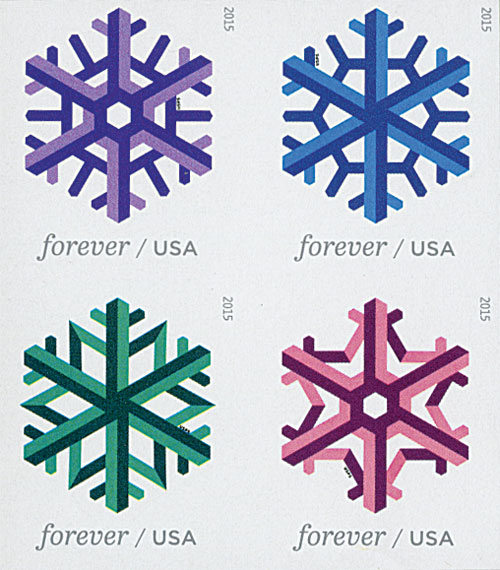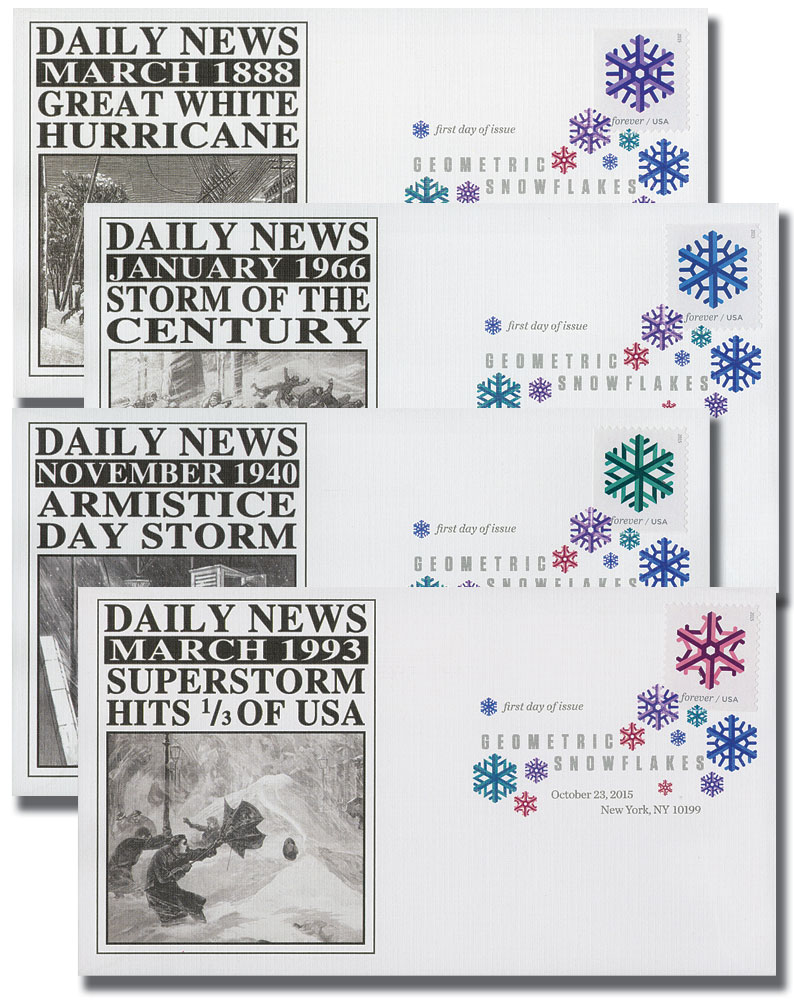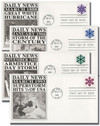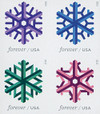
# 5031-34c - 2015 First-Class Forever Stamp - Imperforate Geometric Snowflakes
U.S. # 5031-34c
2015 49¢ Imperforate Geometric Snowflakes
Holiday Celebrations
Â
Value: 49¢ 1-ounce first-class letter rate
Issued: Â October 23, 2015
First Day City:Â New York, NY
Type of Stamp: Commemorative (Imperforate)

Printed by: Banknote Corporation of America for Sennett Security Products
Method: Offset printing in double-sided booklets 20

Self-Adhesive
Quantity Printed: 120,000 stamps
Snowflake stamps have proved a popular wintertime favorite since the first set was issued in 2006 in four different formats (U.S. #4101-16). There was also a set of four snowflake stamps issued in 2013 (U.S. #4808-12)
The Blizzard Of 1888 And Blizzard MailÂ

On March 12, 1888, a short-lived blizzard mail service delivered letters to New York City during one of the worst storms in history.
Just two days before, on March 10, temperatures in the northeast were in the mid-50s. But the next day, cold Arctic air from Canada met with Gulf air from the south sending temperatures plummeting. The rain quickly became snow and winds reached hurricane-strength – about 85 miles per hour in New York City.

When the people of New York awoke on March 12, it was a complete whiteout. Some brave residents ventured out into the cold to board the city’s elevated trains to go to work. But the trains were blocked by snowdrifts and couldn’t move. About 15,000 people were stranded on these trains and had to be rescued by people with ladders. Above ground telegraph lines, water mains, and gas lines were also badly damaged and inoperable.
Because of the bad weather, mail service halted in New York City and the surrounding areas. But the mail was so important to some businesses, they arranged for their own delivery! AW Seward and Dr. WH Mitchell hired a special messenger to take mail aboard the Steamer Chancellor of the New Jersey Central Railroad from Bergen Point, Bayonne, to New York City. Over the course of four days, about 500 letters were transported. Much of the mail consisted of stories from newspaper reporters in Bayonne to their papers in the city.

To facilitate this special service, Seward and Mitchell also had about 500 special stamps printed . The stamps pictured the state of New Jersey coat of arms, “Blizzard Mail To,†“Five Cents,†and “N.Y.P.O.†Printed one at a time, the stamps were affixed to their letters along with the current 2¢ stamp.

By the time the storm ended, as much as 55 inches had fallen in some areas and over 400 people had died between Washington, DC, and Maine. Once the storm passed, officials recognized the issues of having the telegraph, water and gas lines as well as the trains above ground and began the process of moving them all underground.
U.S. # 5031-34c
2015 49¢ Imperforate Geometric Snowflakes
Holiday Celebrations
Â
Value: 49¢ 1-ounce first-class letter rate
Issued: Â October 23, 2015
First Day City:Â New York, NY
Type of Stamp: Commemorative (Imperforate)

Printed by: Banknote Corporation of America for Sennett Security Products
Method: Offset printing in double-sided booklets 20

Self-Adhesive
Quantity Printed: 120,000 stamps
Snowflake stamps have proved a popular wintertime favorite since the first set was issued in 2006 in four different formats (U.S. #4101-16). There was also a set of four snowflake stamps issued in 2013 (U.S. #4808-12)
The Blizzard Of 1888 And Blizzard MailÂ

On March 12, 1888, a short-lived blizzard mail service delivered letters to New York City during one of the worst storms in history.
Just two days before, on March 10, temperatures in the northeast were in the mid-50s. But the next day, cold Arctic air from Canada met with Gulf air from the south sending temperatures plummeting. The rain quickly became snow and winds reached hurricane-strength – about 85 miles per hour in New York City.

When the people of New York awoke on March 12, it was a complete whiteout. Some brave residents ventured out into the cold to board the city’s elevated trains to go to work. But the trains were blocked by snowdrifts and couldn’t move. About 15,000 people were stranded on these trains and had to be rescued by people with ladders. Above ground telegraph lines, water mains, and gas lines were also badly damaged and inoperable.
Because of the bad weather, mail service halted in New York City and the surrounding areas. But the mail was so important to some businesses, they arranged for their own delivery! AW Seward and Dr. WH Mitchell hired a special messenger to take mail aboard the Steamer Chancellor of the New Jersey Central Railroad from Bergen Point, Bayonne, to New York City. Over the course of four days, about 500 letters were transported. Much of the mail consisted of stories from newspaper reporters in Bayonne to their papers in the city.

To facilitate this special service, Seward and Mitchell also had about 500 special stamps printed . The stamps pictured the state of New Jersey coat of arms, “Blizzard Mail To,†“Five Cents,†and “N.Y.P.O.†Printed one at a time, the stamps were affixed to their letters along with the current 2¢ stamp.

By the time the storm ended, as much as 55 inches had fallen in some areas and over 400 people had died between Washington, DC, and Maine. Once the storm passed, officials recognized the issues of having the telegraph, water and gas lines as well as the trains above ground and began the process of moving them all underground.










